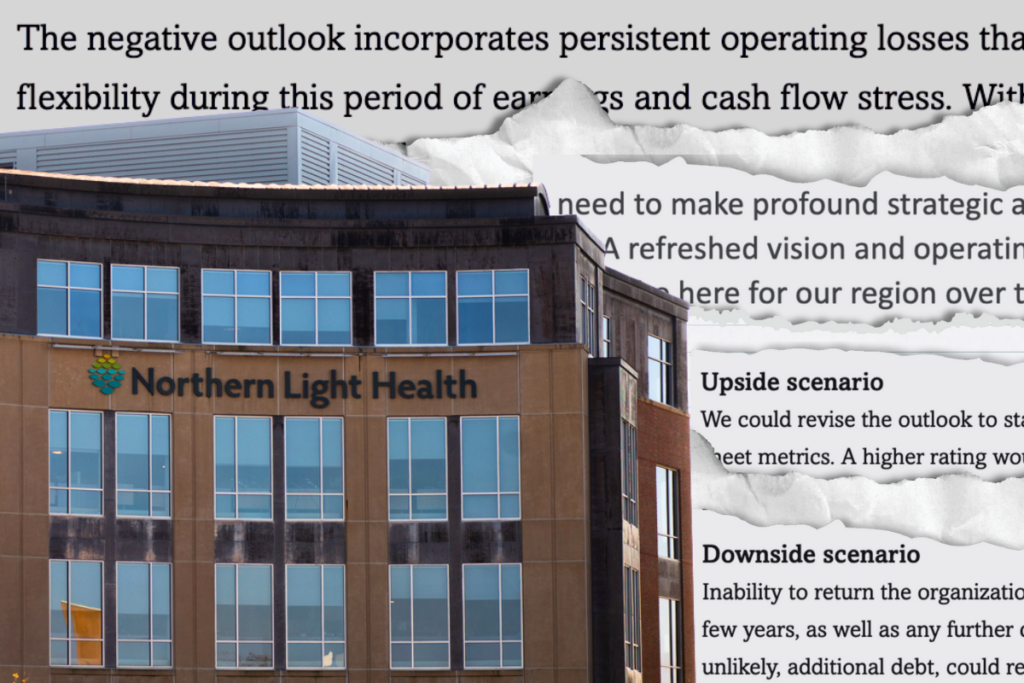
What’s next for a reeling Northern Light Health
By Annie Rupertus, Bangor Daily News Staff
Despite seeming to be in free fall for months, Northern Light Health insists it’s not looking to sell its hospitals — and experts say the health care system can avoid that drastic step if it acts quickly.
In recent years, Northern Light has seen hospital closures, resignations by top executives and enormous financial losses. The system lost $156 million in the most recent fiscal year and closed its Waterville hospital last month. Northern Light’s credit rating also took significant hits last year.
The flurry of changes has stoked fears around what could happen to the essential services Northern Light provides for Mainers. And while the system issued a vague warning earlier this month of coming changes, including potential staffing cuts, its leaders said there’s no sale in the works.

“We have no interest in selling and there’s been no party who’s reached out to buy,” said Paul Bolin, executive vice president and chief people and administrative officer. “That’s not at all what we see as part of our future.”
Northern Light is also “not closing any hospitals moving forward,” according to Lisa Harvey-McPherson, the health system’s vice president of government relations, despite studies showing federal cuts to Medicaid could put Northern Light hospitals in Presque Isle and Ellsworth at risk of closure.
For the past year, ongoing turmoil at Northern Light Health — Penobscot County’s biggest employer and one of the state’s biggest health care providers — has raised questions about what will become of the health care system. Two experts who reviewed recent Northern Light financial documents told the Bangor Daily News that while the system is not in immediate danger of failing, it faces an uphill battle to sustainability.
“They’re going in the right direction, but there’s still clouds on the horizon,” said Nancy Kane, a former professor of health policy and management at Harvard University.
Kane analyzed Northern Light’s financial data from the second quarter of 2025, and found that its operating margin had improved from -7.2 percent last year to 2.2 percent in the first half of the current fiscal year, which she said was a good sign.
Bankruptcy likely isn’t imminent for Northern Light, but the nonprofit needs to act now to cut its losses, said Joshua Nemzoff, a Pennsylvania-based health care CEO and hospital mergers and acquisitions expert who reviewed Northern Light’s financial audit from 2024.
“You cannot be losing $156 million a year if you want to stay in business long term,” he said. “The dumbest thing in the world you could possibly do is just sit there and continue losing that much money and watch all your cash disappear.”
Northern Light will have to cut services and decrease its labor costs, according to Nemzoff. He said this could include reducing physicians’ salaries, cutting positions or eliminating services that are losing the most money.
Hospital boards are sometimes hesitant to “deal with some of the ugly truths” of cutting staff and services to recover from financial losses, Nemzoff said.
Recent financial documents obtained by the BDN reveal some details about Northern Light’s plan to claw its way back from last year’s $156 million operating loss.
It includes reducing costs by “restructuring shared services,” as well as reducing reliance on contract labor and temporary physicians by focusing more on recruiting and keeping permanent staff, according to a financial improvement plan included in Northern Light’s 2024 financial audit.
The organization also plans to gain $63.5 million in 2025 through initiatives such as implementing “new clinical models” at Northern Light Eastern Maine Medical Center and reviewing traveler positions, according to a slideshow Northern Light presented to the bond-issuing organization for Maine hospitals in January.
The changes at EMMC will focus on the services that can only be provided there, according to Bolin. He declined to share which services are at risk of being cut, saying that Northern Light is still working to determine a plan following its recent warning that changes are coming.
Northern Light’s 2025 budget aims to increase patient service revenue by more than $150 million. It projects a $16 million operating loss for 2025 — an improvement of $140 million from last year.
“They got their work cut out for them,” Kane said.
It could become even harder for Maine hospitals to stay afloat due to the Medicaid cuts included in President Donald Trump’s One Big Beautiful Bill Act, which he signed into law on July 4.
About 65 percent of Northern Light’s revenue comes from MaineCare, Medicare and Medicaid.
Northern Light leaders are still unsure exactly how the federal cuts will impact the system’s financial plan and are waiting for more information from MaineCare, according to Harvey-McPherson.
As hospitals around the state face mounting challenges, others have considered selling.
Another large Maine hospital system, Central Maine Health Care, announced earlier this year its purchase by a nonprofit based in California. The system had also faced serious financial challenges, with deficits of $19 million or more in recent years.
Although Northern Light leadership says there is no plan to sell, Kane said that if the health system were to start having trouble keeping physicians and patients because it couldn’t maintain the right equipment and facilities, that’s when “you really go into a downward spiral and you have to find a partner.”
If Northern Light were to try to sell, its options would be limited by a new law enacted by the Maine Legislature as an emergency measure last month.
The bill, sponsored by Sen. Mike Tipping, D-Penobscot, placed a one-year moratorium on hospital acquisitions by private equity companies or real estate investment trusts.
Seeing hospital systems like Northern Light and others in the state struggle financially partly motivated Tipping’s introduction of the bill, he said.
Tipping said Northern Light “was certainly in mind for me, and I’ve been concerned about some of the moves they’ve made.” While he wasn’t aware of an immediate private equity threat to the system, he feared the effects such a future sale could have.
High-profile crises have occurred in other states following sales of hospitals to private equity, including the collapse of the Texas-based Steward Health Care system, the largest for-profit hospital system in the country that grew out of a sale by the Boston Catholic Archdiocese to a private equity company.
Maine AllCare, a nonprofit health care advocacy group that partnered with Tipping to introduce the bill, said in a statement the recent closure of Northern Light’s Waterville hospital highlighted its concerns of protecting Maine’s hospitals “against the documented harms of private equity involvement in health care.”
“They’re going through difficult times and we don’t want vultures descending on them,” Tipping said of hospitals in the state.